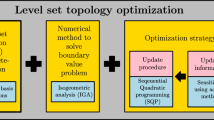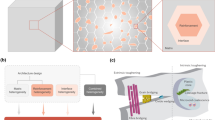Abstract
Being one of new generation of composites, functionally graded materials (FGMs) possess gradually changed physical properties due to their compositional and/or microstructural gradients. In literature, exhaustive studies have been carried out in compositional modeling and design, while limited reports are available for microstructural optimization. This article presents an inverse homogenization method for the design of two-phase (solid/void) FGM microstructures, whose periodic base cells (PBCs) vary in a direction parallel to the property gradient but periodically repeat themselves in the perpendicular direction. The effective elasticity tensor at each PBC is estimated in terms of the homogenization theory. The overall difference between the effective tensor and their target is minimized by seeking for an optimal PBC material topology. To preserve the connectivity between adjacent PBCs, three methods, namely connective constraint, pseudo load, and unified formulation with nonlinear diffusion are proposed herein. A number of two-dimensional examples possessing graded volume fraction and Young’s modulus but constant positive or negative Poisson’s ratios are presented to demonstrate this computational design procedure.












Similar content being viewed by others
References
Niion M, Maeda S (1990) J Iron Steel Inst Jpn 30:699
Miyamoto Y (1999) Functionally graded materials: design, processing and applications. Kluwer Academic Publishers, Boston, London
Paul W (2001) 21st Century manufacturing. Prentice-Hall Inc., New Jersey
Amada S, Untao S (2001) Compos B Eng 32:449
Nogata F, Takahashi H (1995) Compos Eng 5:743
Silva ECN, Walters MC, Paulino GH (2006) J Mater Sci 41:6991. doi:https://doi.org/10.1007/s10853-006-0232-3
Ray AK, Das SK, Mondal S, Ramachandrarao P (2004) J Mater Sci 39:1055. doi:https://doi.org/10.1023/B:JMSC.0000012943.27090.8f
Bendsøe MP, Sigmund O (2003) Topology, optimisation: theory, methods, and applications. Springer, Berlin, New York
Sigmund O (1994) Int J Solids Struct 31:2313. doi:https://doi.org/10.1016/0020-7683(94)90154-6
Sigmund O (1994) Design of material structures using topology optimization. Technical University of Denmark
Bensoussan A, Papanicolaou G, Lions JL (1978) Asymptotic analysis for periodic structures. North Holland Pub Co., Amsterdam
Sanchez-Palencia E (1980) Non-homogeneous media and vibration theory. Springer-Verlag, Berlin
Sigmund O, Torquato S (1996) Appl Phys Lett 69:3203. doi:https://doi.org/10.1063/1.117961
Zhou SW, Li Q (2007) J Phys D Appl Phys 40:6083. doi:https://doi.org/10.1088/0022-3727/40/19/048
Zhou SW, Li Q (2008) J Mater Res 23:798. doi:https://doi.org/10.1557/jmr.2008.0101
Guest JK, Prévost JH (2007) Comput Methods Appl Mech Eng 196:1006. doi:https://doi.org/10.1016/j.cma.2006.08.006
Mumtaz KA, Hopkinson N (2007) J Mater Sci 42:7647. doi:https://doi.org/10.1007/s10853-007-1661-3
Dimitrov D, Schreve K, de Beer N (2006) Rapid Prototyping J 12:136. doi:https://doi.org/10.1108/13552540610670717
Wang JW, Shaw LL (2006) J Am Ceram Soc 89:3285. doi:https://doi.org/10.1111/j.1551-2916.2006.01206.x
Lin CY, Hsiao CC, Chen PQ, Hollister SJ (2004) Spine 29:1747. doi:https://doi.org/10.1097/01.BRS.0000134573.14150.1A
Lin CY, Schek RM, Mistry AS, Shi XF, Mikos AG, Krebsbach PH et al (2005) Tissue Eng 11:1589. doi:https://doi.org/10.1089/ten.2005.11.1589
Hollister SJ (2005) Nat Mater 4:518. doi:https://doi.org/10.1038/nmat1421
Chen KZ, Feng XA (2004) Comput Aid Des 36:51. doi:https://doi.org/10.1016/S0010-4485(03)00077-0
Zhu F, Chen KZ, Feng XA (2006) Adv Eng Software 37:20. doi:https://doi.org/10.1016/j.advengsoft.2005.03.016
Seepersad CC, Kumar RS, Allen JK, Mistree F, McDowell DL (2004) J Comput Aided Mater Des 11:163. doi:https://doi.org/10.1007/s10820-005-3167-0
Schramm U, Zhou M (eds) (2006) Recent developments in the commercial implementation of topology optimization. Springer, Netherlands
Bendsøe MP, Kikuchi N (1988) Comput Methods Appl M 71:197. doi:https://doi.org/10.1016/0045-7825(88)90086-2
Sigmund O (1994) J Intell Mater Syst Struct 5:736. doi:https://doi.org/10.1177/1045389X9400500602
Cheng KT, Olhoff N (1981) Int J Solids Struct 17:305. doi:https://doi.org/10.1016/0020-7683(81)90065-2
Markworth AJ, Ramesh KS, Parks WP (1995) J Mater Sci 30:2183. doi:https://doi.org/10.1007/BF01184560
Mori T, Tanaka K (1973) Acta Metall 21:571. doi:https://doi.org/10.1016/0001-6160(73)90064-3
Hill R (1965) J Mech Phys Solids 13:213. doi:https://doi.org/10.1016/0022-5096(65)90010-4
Reiter T, Dvorak GJ, Tvergaard V (1997) J Mech Phys Solids 45:1281. doi:https://doi.org/10.1016/S0022-5096(97)00007-0
Hashin Z, Shtrikman S (1962) J Appl Phys 33:3125. doi:https://doi.org/10.1063/1.1728579
Zhou SW, Li Q (2008) Compu Mater Sci in progress
Zhou M, Rozvany GIN (1991) Comput Methods Appl Mech Eng 89:309. doi:https://doi.org/10.1016/0045-7825(91)90046-9
Stolpe M, Svanberg K (2001) Struct Multidiscip Optim 22:116. doi:https://doi.org/10.1007/s001580100129
Bendsoe MP, Sigmund O (1999) Arch Appl Mech 69:635. doi:https://doi.org/10.1007/s004190050248
Svanberg K (1987) Int J Numer Methods Eng 24:359. doi:https://doi.org/10.1002/nme.1620240207
Haug EJ, Choi KK, Komkov V (1986) Design sensitivity analysis of structural systems. Academic Press, Orlando
Aubert G, Kornprobst P (2006) Mathematical problems in image processing: partial differential equations and the calculus of variations. Springer, New York
Wang MY, Zhou S, Ding H (2004) Struct Multidiscip Optim 28:262. doi:https://doi.org/10.1007/s00158-004-0436-6
Bourdin B (2001) Int J Numer Methods Eng 50:2143. doi:https://doi.org/10.1002/nme.116
Brandel B, Lakes RS (2001) J Mater Sci 36:5885. doi:https://doi.org/10.1023/A:1012928726952
Acknowledgement
The financial supports from Australian Research Council (Nos. DP0558497 and DP0773726) are acknowledged.
Author information
Authors and Affiliations
Corresponding author
Rights and permissions
About this article
Cite this article
Zhou, S., Li, Q. Design of graded two-phase microstructures for tailored elasticity gradients. J Mater Sci 43, 5157–5167 (2008). https://doi.org/10.1007/s10853-008-2722-y
Received:
Accepted:
Published:
Issue Date:
DOI: https://doi.org/10.1007/s10853-008-2722-y




